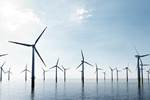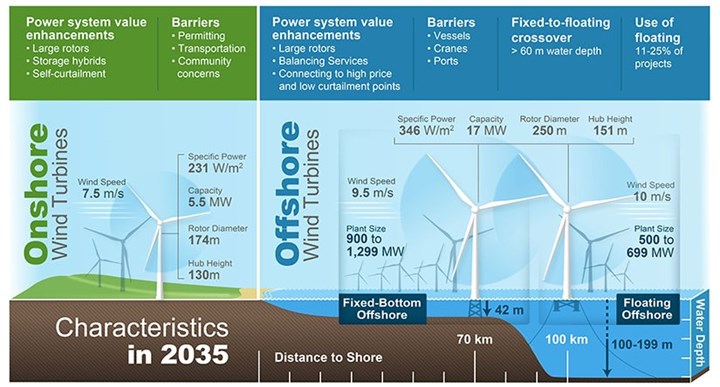Experts forecast taller, more economical wind plant designs in the future
NREL researchers elicited more than 140 professional opinions concerning 2035 expectations, noting onshore wind turbines reaching 130 meters and plant sizes up to 1,100 MW.
Anticipating key features of wind plants a decade or more ahead of their installation can inform today’s investment, research and energy system planning decisions. Researchers Philipp Beiter and Eric Lantz from the National Renewable Energy Laboratory (NREL, Golden, Colo., U.S.), together with collaborators from the Lawrence Berkeley National Laboratory (LBNL, Berkeley, Calif., U.S.) and the U.S. Department of Energy (DOE, Washington, D.C., U.S.), elicited opinions from more than 140 of the world’s leading experts about their expectations of future wind plant design in 2035.
In their new article, “Expert Perspectives on the Wind Plant of the Future,” which appears in the journal Wind Energy, the researchers find that experts expect wind turbines to increase to greater heights than previously forecast, with plants located increasingly in less favorable wind and siting regions.
Taller turbines, and their accompanying larger rotor diameters, enable for the capture of more energy, the NREL notes. In the most-likely scenario, the experts predicted that hub height for newly installed onshore wind turbines will reach 130 meters in 2035, rather than the 115-meter forecast offered in a 2015 survey. (Each survey asked experts to look 15 years into the future, so the 2015 data offers predictions for 2030).
Relatively few efforts have systematically investigated the exact mechanisms driving wind plant design.
Experts expect plant sizes of 1,100 megawatts (MW) for fixed-bottom and 600 MW for floating offshore wind. These and many other design choices discussed in the article can reportedly support levelized cost of energy (LCOE) reductions of 27% (onshore) and 17%–35% (floating and fixed-bottom offshore) by 2035 compared to today. New plant designs can also enhance wind energy’s grid service, for example, via project hybridization with batteries and hydrogen production.
“Our research provides a much-needed benchmark for representing future wind technologies in power sector models,” Beiter says. “By explaining the economics behind wind energy design choices, this article addresses a critical research gap.”
The authors identify economic mechanisms that drive these design changes, including economies of scale from larger turbines, larger plant size and greater siting flexibility. In essence, these mechanisms drive design choices because the value from reduced costs or higher energy production exceed the incremental expense to obtain them.
“While well established in broader economic theory and often addressed individually, relatively few efforts have systematically investigated the exact mechanisms driving wind plant design,” Lantz points to the contribution of the study.
The comprehensive global expert survey was made possible through an international research partnership under the auspices of the International Energy Agency Wind Technology Collaboration Programme, whose mission is to advance wind energy research, development and deployment in its member countries. The DOE’s Wind Energy Technologies Office funded the research.
NREL is the U.S. DOE’s primary national laboratory for renewable energy and energy efficiency research and development. NREL is operated for the Energy Department by the Alliance for Sustainable Energy LLC.
Related Content
-
Novel composite technology replaces welded joints in tubular structures
The Tree Composites TC-joint replaces traditional welding in jacket foundations for offshore wind turbine generator applications, advancing the world’s quest for fast, sustainable energy deployment.
-
Drag-based wind turbine design for higher energy capture
Claiming significantly higher power generation capacity than traditional blades, Xenecore aims to scale up its current monocoque, fan-shaped wind blades, made via compression molded carbon fiber/epoxy with I-beam ribs and microsphere structural foam.
-
Hexagon Purus opens new U.S. facility to manufacture composite hydrogen tanks
CW attends the opening of Westminster, Maryland, site and shares the company’s history, vision and leading role in H2 storage systems.














.jpg;maxWidth=300;quality=90)


